8 Best Mountain Bike Backpacks in 2023
Check out the best mountain bike backpacks that will keep you hydrated and carry all your trail tools, snacks, and layers for every ride.
If there’s one thing you always carry with you on a ride, let it be water. Ideally, you’d also have some basic trail fix-it tools like a multi-tool, some tire plugs, a hand pump, and a few snacks in your mountain bike backpack but water is really the essential item. Even if you’re just going out for a short spin, it’s a good idea to get into the habit of always bringing water. You don’t want to find yourself stranded and parched, right? Right.
There are a few options for carrying water as a mountain biker, but my personal favorite is a backpack with a hydration reservoir for a water bladder. I like backpacks because they can carry extra gear (see my post on What To Carry In Your Pack) and I find that they’re more comfortable and accessible than a fanny pack.
There are a ton of different options out there for good mountain bike backpacks and in this post, I’ve rounded up a few of the best.
A good mountain bike backpack should allow for airflow between your shirt and the back panel, have small pockets to keep things organized (some even come with built-in tool rolls), and be lightweight so that the straps don’t hurt your neck and shoulders.
Tops Picks at a Glance
Here are (what I consider) to be the best mountain bike hydration packs and backpacks on the market
Buying Guide – FAQs & Features
Not sure what to look for? Here are some FAQs and tips to consider when shopping around for a mountain bike hydration pack.
The Osprey Raven (or Raptor for the guys) has quickly become my favorite hydration pack for mountain biking.
It is specifically designed for mountain bikers with an integrated tool roll, a helmet lid-lock carry system (for when you’re not riding your bike, obvs…), and plenty of pockets to stash your snacks, spares, sunglasses, and other trail necessities.
I also love that the back panel is mesh to provide good ventilation because I don’t know about you, but I get sweaty on those climbs.
Unlike other hydration packs, the Raven and Raptor come with an included 2.5 L hydration reservoir.
I do find that refilling the reservoir isn’t as easy with these packs because you can’t unclip the hose from the bladder, but the other features definitely make up for this minor inconvenience.
The Osprey Raven and Raptor packs come in two sizes: 10L and 14L. I use the 10 L pack and find it the perfect size for everyday riding.

If you’re a heavy sweater or live in a hot/humid climate, take a look at the Dakine Drafter hydration pack. I used a similar model – the Dakine Syncline – for many seasons and while I liked that pack, I’d choose the Drafter next time.
The Dakine Drafter is designed with an awesome AirLite Suspension back panel that allows air to flow between you and the pack. It also has breathable shoulder straps for even more ventilation.
Dakine uses a lumbar hydration reservoir system where the bladder sits low on the back instead of vertically along the spine. I honestly didn’t notice too much of a difference in how it sits on the Syncline, but what I do like about this system is that it’s really easy to access the reservoir from the bottom compartment. Other packs, like Osprey, require you to pull the reservoir out from the top of a hydration sleeve which can be awkward.
I also really like that you can detach the hose from the reservoir with a quick-connect for easy filling, which Osprey doesn’t do for some reason.
The one thing I don’t love about the Drafter is the questionable color choices… You’ll either love them or hate them. The zippered front pocket is also located inside the stash flap, which is a bit weird and awkward to access.
The Dakine Syncline does come in a 14 L version, but I find that to be a bit big for most mountain biking adventures.

For those riders (looking at you, cross-country chargers) that don’t want to carry a heavy pack, but also don’t like the idea of only relying on water bottles, the EVOC Hydro Pro (smaller version) is the perfect solution.
Both pack sizes come with a 1.5 L hydration reservoir that slips into the back panel while the two front mesh chest pouches can store easy-to-access snacks and gels.
There are two zippered pockets on the chest straps as well that you can store tools and spares, but you don’t want to load them up too much, or else they’ll feel bulky and uncomfortable.
I personally wouldn’t use this vest-style hydration pack because I like to carry more than 1.5 L of water, especially on bigger rides, but if you don’t need as much water or you know you’ll be able to fill up the EVOC Hydro Pro could be a great option.
USWE is a brand out of Sweden that is wire widely known amongst moto and dirt bikers, but their hydration packs are becoming more and more popular with mountain bikers thanks to their no-bounce design.
Instead of using traditional straps and clips, USWE uses a suspension harness system (awesomely called No Dancing Monkeys, or NDM) that minimizes bounce on the back while still allowing you to move freely. If you tend to ride rowdy trails, these packs are for you!
While I haven’t tried a USWE pack out on the trail, I have tried one on to experience the NDM harness and I have to say, it’s quite snug! I also have several moto friends who use USWE packs and they swear by the design.
USWE has several different pack collections, but their Airborne Series is designed for mountain bikes and has two different pack sizes to choose from: 3 L and 9 L. Both sizes have tool pouches, an included water reservoir, and the No Dancing Monkeys harness.
One cool thing about the 3 L pack is that you can remove the small outer pouch to shave off some weight if you’re doing a race or just heading out for a quick spin. I wish they’d designed the 9 L pack to have this versatility as well.
The one major downside to USWE packs is that they may not fit comfortably for women with large chests.
For the riders who don’t need all the bells and whistles like pockets and organization, the Osprey Kitsuma (women’s) and Osprey Katari (men’s) packs are the perfect answers.
With a minimal design, these hydration packs – which are available in 1.5 L, 3 L, and 7 L models – are meant for casual riding or fast, lightweight missions where you only need to pack the essentials.
Each model comes with a hydration reservoir, but they do lack the mountain bike-specific features found on the Osprey Raven and Raptor like the integrated tool roll, helmet lid lock, snack pockets on the hip belt, etc…
The back ventilation also isn’t quite as robust, although the slimmer design does allow for good airflow.
One big plus for the Kitari and Kitsuma packs is that they are also great for day hikes if you want a versatile hydration pack.
Ideal for trail riders looking for a relatively compact mountain biking backpack that still has lots of pockets for organization, the Evoc Stage 12 is a great option. It’s designed with an easy-to-reach tool compartment as well as numerous pockets to stash your snacks, spares, and other items. As a guide or instructor, this pack is great for carrying all your extra gear and essentials.
The EVOC Stage is also great for year-round riding thanks to the integrated rainfly that stuffs into its own little compartment at the bottom. Raining out? No problem, just pull the cover up and keep pedaling.
Lastly, if you struggle to find a pack to fit your wide shoulders, this one could be a great choice thanks to the shoulder strap design that allows the straps to move side-to-side to accommodate broader shoulders.
If you want a smaller or larger size, the EVOC Stage also comes in 6 L or 18 L models.
I feel like there are two types of outdoorsy people: Osprey supporters and CamelBak supporters. I, personally, am team Osprey but if you’re CamelBak-loyal check out the CamelBak M.U.L.E. hydration backpack (men’s).
This pack has most of the great features the other packs on this list are designed with, but the biggest difference is the hydration reservoir. CamelBak reservoirs use a screw-on ‘lid’ rather than a sliding closure. I find them to be a bit finicky and hard to fill, but that’s my personal opinion.
The M.U.L.E. is pretty spacious with two main zippered pockets and several smaller organizational pockets.
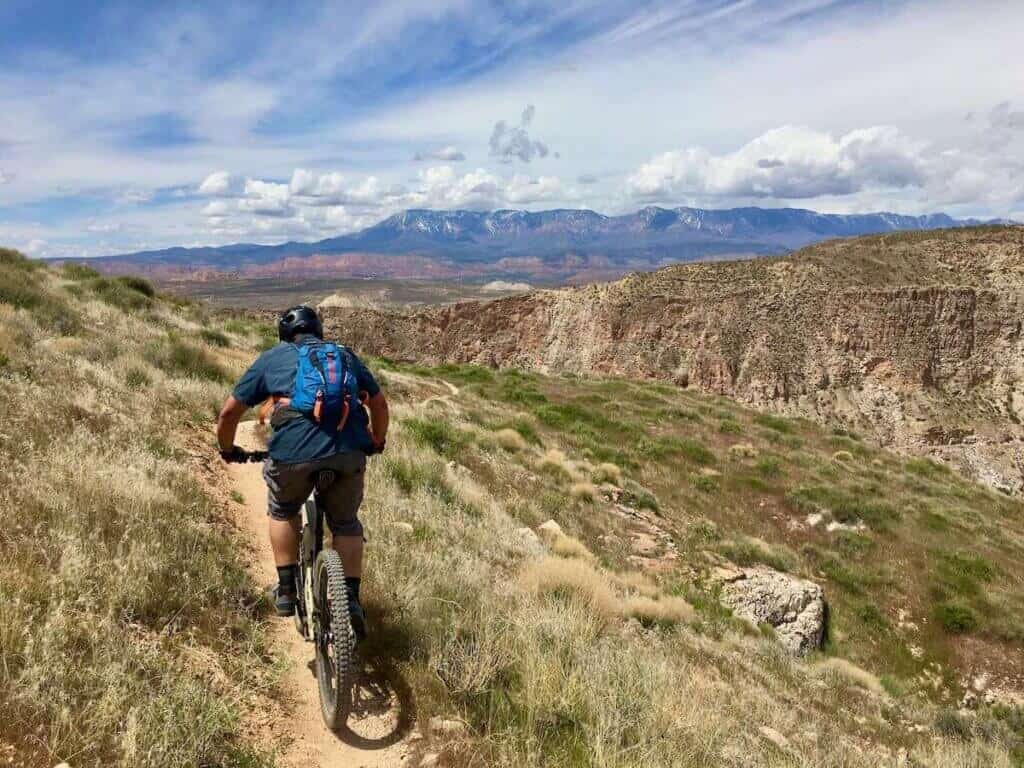
Need a pack to carry all your trail building and maintenance tools? (First off, thanks for your work!) The EVOC Trail Builder is specifically designed for trail builders to carry their heavy equipment from chainsaws to axes to hoes and more.
While this pack doesn’t have an internal frame, it does have a robust design that allows you to carry heavy loads easily and without too much discomfort.
It’s also got a ton of pockets and storage compartments to keep your gear organized so you can quickly move along the trail.
Comparison Table
| Pack | TWW Award | Gear Capacity | H2O Capacity | Price |
|---|---|---|---|---|
| Osprey Raptor & Raven | Two Wheeled Wanderer Favorite | 10 L, 14 L | 2.5 L | $165/$175 |
| Dakine Drifter | Best Ventilation | 10 L, 16 L | 3 L | $160/$190 |
| EVOC Hydro Pro | Best Hydration Vest | 1.5 L, 3 L | 1.5 L | $130/$140 |
| USWE Airborne | Best for Rowdy Riders | 3 L, 9 L | 2 L, 3 L | $125/$140 |
| Osprey Kitsuma & Katari | Best for Minimalists | 1.5 L, 3 L, 7 L | 1.5 L, 2.5 L | $70/$80/$90 |
| EVOC Stage 12 | Best for Organization | 12 L | 3 L (not included) | $160 |
| CamelBak M.U.L.E. | CamelBak Lovers | 9 L | 3 L | $130 |
| EVOC Trail Builder | Trail Builders | 30 L | 3 L (not included) | $300 |
Other Ways to carry water on your bike
Fanny Pack
Some people really like using a fanny pack (aka hip pack if you didn’t grow up in 80’s) instead of a backpack. Personally, I haven’t found a fanny pack that works for me because I feel like they sag in the back and dig into my stomach.
Some people avoid that sag by only carrying tools and snacks in their fanny pack and using water bottle cages for water.
That being said, some people – like my brother – only ride with fanny packs, so if you think they might work for you, give it a try! He uses the EVOC Hip Pack Pro.
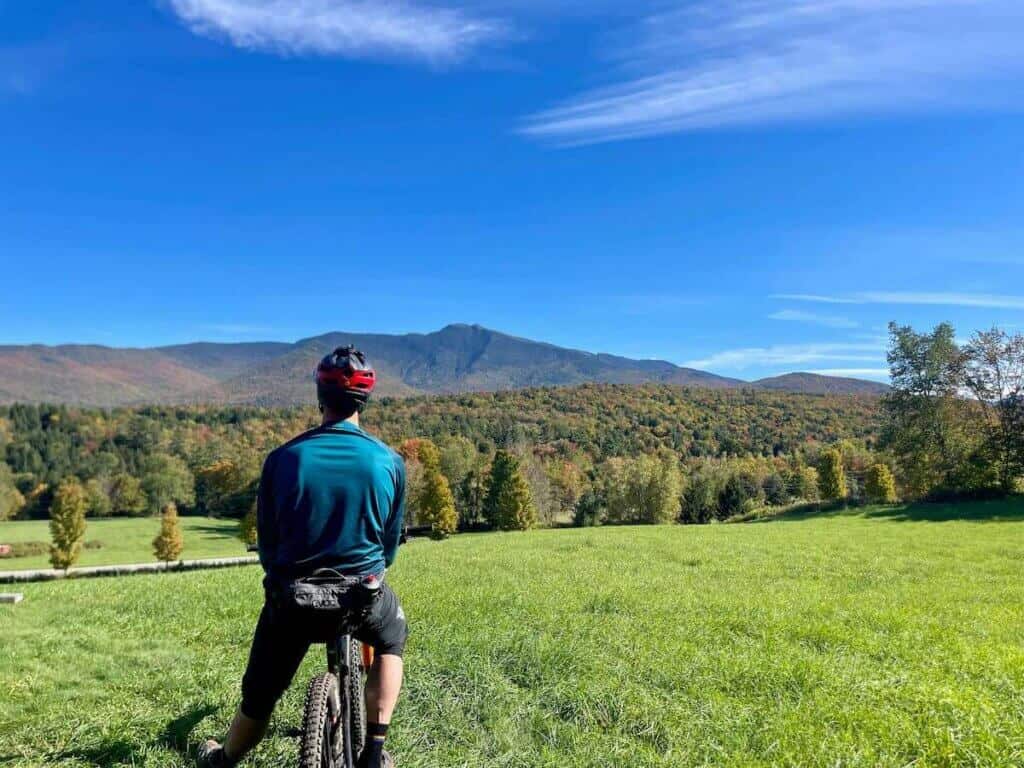
Water Bottle Cage
Water bottle cages are great for shorter rides, but I wouldn’t recommend relying on them solely for big rides or rowdy terrain. I’ve had water bottles go flying off my bike on rocky descents and I’ve actually seen the top of a water bottle get sheared off when it made contact with the front wheel on a big compression.
Use them for short spins, but don’t rely on them for bigger rides.
Water Filter Bottle
I was riding with one of my brother’s friends a while ago and during a quick rest stop, he walked over to the river and filled up his LifeStraw Squeeze soft water bottle filter. I thought that was a super clever way to carry water on big rides!
Of course, this solution will only work if you are sure there is going to be water along your route.
Final thoughts
There’s no one-size-fits-all when it comes to the ‘best’ mountain bike hydration backpack. It really comes down to personal preference, what kind of riding you’ll be doing the most, how much stuff you need to carry, etc…
Take your time and really think about what features are most important to you. There are lots of options out there, so with a little shopping around I’m confident you’ll find the right one for your adventures.
Happy trails!
RELATED POSTS
Looking for more round-ups to upgrade your gear closet this season? Check out these related blog posts:
I hope this roundup helps you find the best mountain biking hydration pack for your rides! Do you have a favorite mountain biking backpack not listed above? Which one and why do you love it? Leave a comment below!

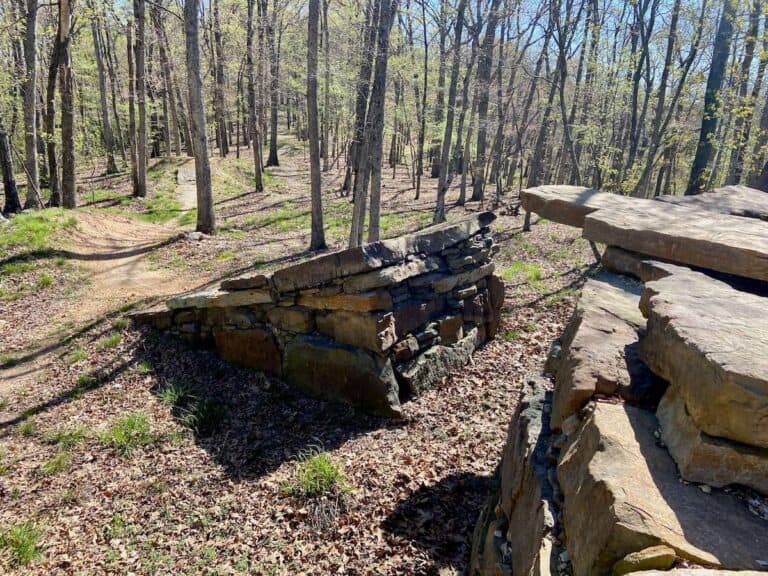

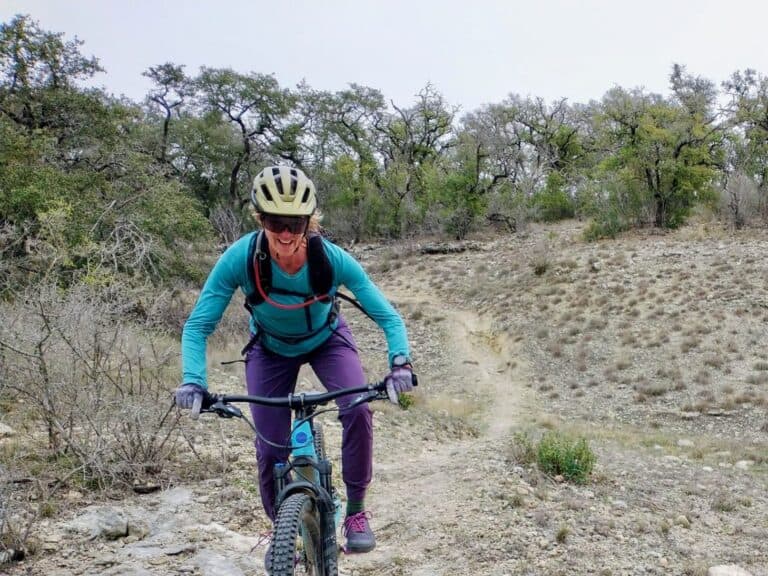

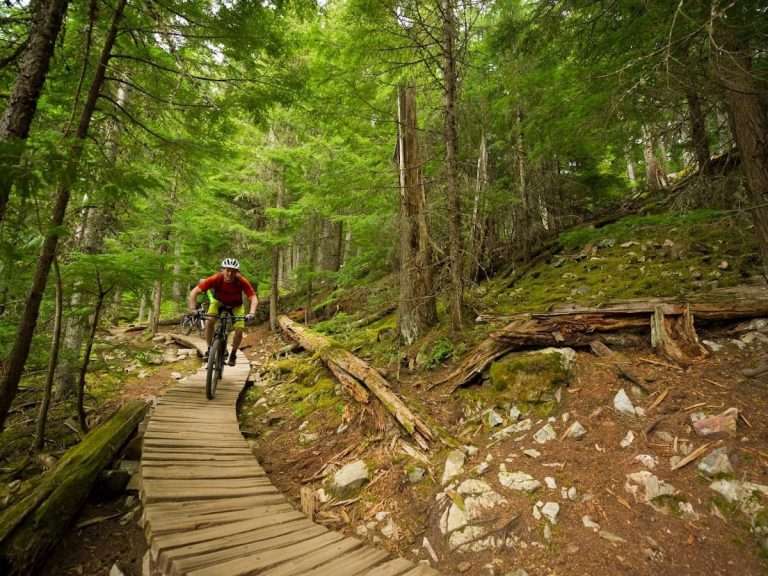

There is a brand called Source that I like. The bladder that holds the water is the best I have used so far. Really easy to clean and very durable. The backpacks are decent too but I think that quality wise their are other options that could be better. https://sourceoutdoor.com/product-category/hydration/